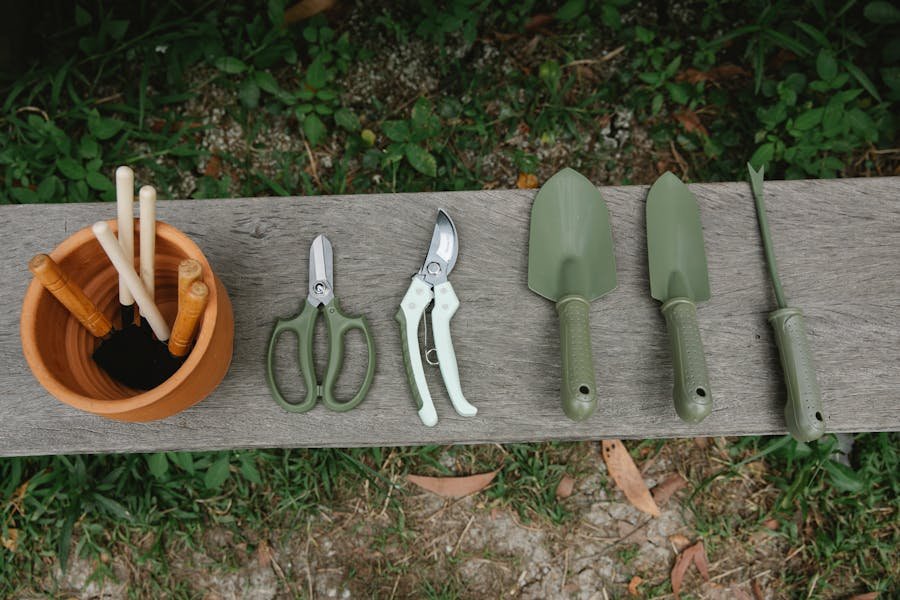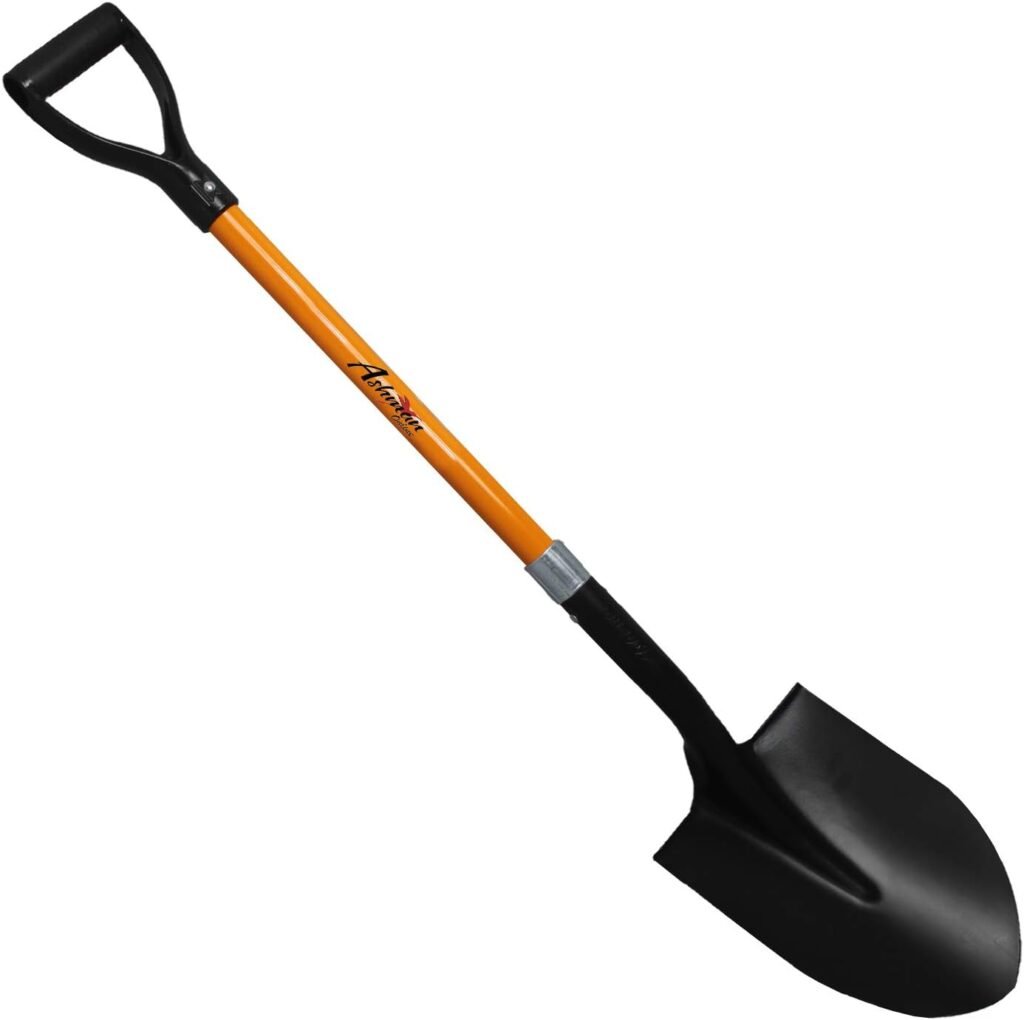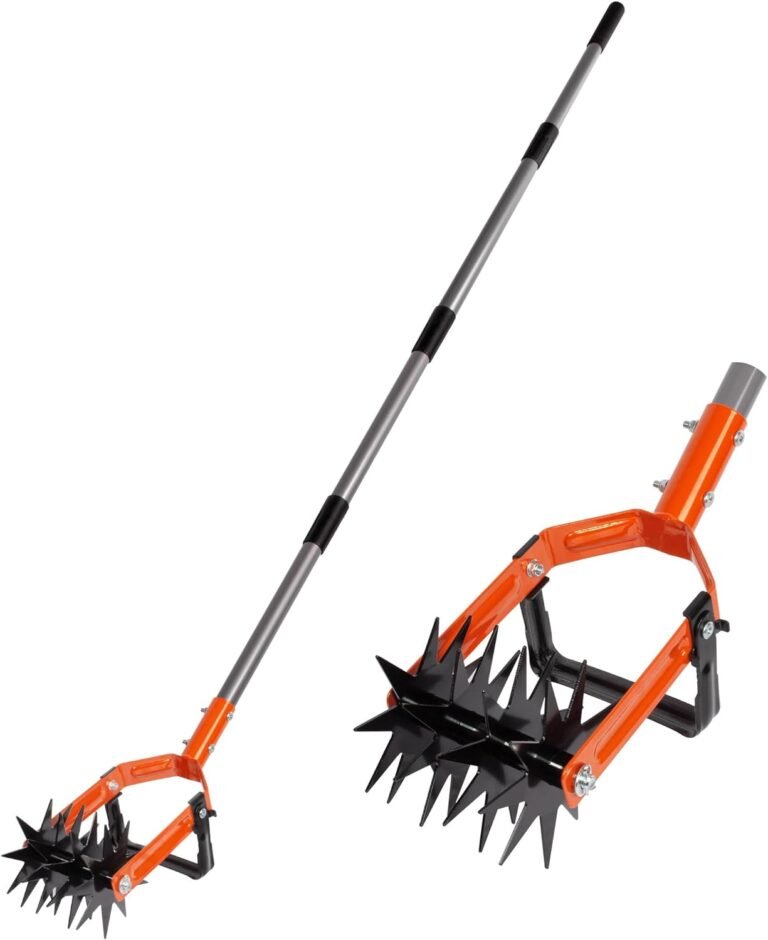Are you baffled by the array of garden tools cluttering your shed or the nearby store? Living in a time with so many different useful tools and garden tool names, we are usually left asking ourselves, “what is this thing called, and what’s it for?”
Well… If you’ve ever found yourself scratching your own head over whether that thingamajig is for pruning or digging then, fear not! You’re about to become a garden tool guru.
We’ll cover everything from the trowel, ideal for small digging jobs and planting bulbs, to the powerful rototiller, which can revolutionize soil preparation in larger gardens. These tools will help you plant, prune, and produce like a pro.
This guide doesn’t just list tools; it will teach you when and how to use them. We have also listed some quick product recommendations to get you started.
Lets start off with the basics for starting and maintaining your garden space.
Shovel Garden Tool Names & Types
The shovel is arguably the backbone of any garden arsenal.
Use cases: Ideal for digging, lifting, and moving bulk materials like soil or mulch
Design features: It comes in various shapes and sizes tailored to specific tasks. A round-point shovel, for instance, is perfect for digging holes for plants and trees, while a flat shovel is better suited for slicing through sod or scraping clean flat surfaces.
Spade
Remember, the spade is your go-to for precision work in the garden.
Use cases: Designed for digging in tough soil, edging garden beds, and transplanting smaller plants and shrubs.
Design Features: It’s sharp edge makes it excellent for creating neat, straight garden lines. Spades are similar to shovels but feature a flat blade and a shorter handle.
Rake
Use Cases: Rakes are good for smoothing out soil, clearing leaves, and breaking up soil when leveling beds.
Design Features: There are two primary types: the leaf rake, which has long, flexible tines for gathering leaves without damaging plants; and the garden rake, with shorter, stiffer tines for breaking up soil clumps and leveling beds.
Hoe Garden Tool Names
The hoe is an ancient and versatile gardening tool.
Use Cases: Used for shaping soil, removing weeds, clearing soil, and harvesting root crops.
Design Features: There are several types of hoes – paddle, stirrup, and dutch – each designed for different gardening tasks. For example, a stirrup hoe is great for cutting weeds just below the soil surface on a back-and-forth motion.
Hand Trowel
An indispensable tool for the close-up work of gardening.
Use Cases: Perfect for digging small holes, transplanting seedlings, mixing fertilizer or other additives, and moving soil in a pot.
Design Features: Look for one with a sturdy handle and a comfortable grip to make your gardening tasks a breeze.
Pruning Shear Garden Tool Names
Use Cases: Pruning shears are essential for shaping plants, snipping off dead or overgrown branches, and maintaining the health and aesthetics of your garden.
Design Features: There are several types, including anvil, bypass, and ratchet pruners, each suited to different types of plants and tasks. Bypass pruners are great for live plants and green wood, providing a clean cut that promotes healing. Anvil pruners are great for thick stems. Ratchet pruners allow you to cut using multiple squeezes which allows a more ergonomic option.
Ergonomic Shovel
- Ergonomic Grip
- Long Handle (42 inch)
- Durable Round Blade
- Multi Use (Gardening, Trenching, Transplanting)
- Quality Long Term Investment
Spade
- Wooden & Metal Handle
- Unique Non-Slip Design
- 43 Inches
- Great For Digging & Edging
Rake
- Stainless Steel / Anti-Rust Materials
- 17 Tine Wide Rake Area
- Good For Breaking Soil, Spreading, and Leveling
- Adjustable Length
- Ergonomic Grip
Garden Hoe
- Anti Blister COMFORTGEL Grip
- 2 In 1 Cultivator And Hoe
- 36-in Reach
- Ideal For Urban Gardening & Raised Beds
- High Quality Steel Material
Hand Trowel
- Quality Stainless Steel
- Anti-Rust
- Ergonomic Grip
- Features A Serrated Blade For Weed Control
- Multi-Use (Digging, Weeding, Precise Bulb Planting)
- Features A Measuring Ruler For Precision
Pruning Shears (Ratchet Type)
- Increases Cutting Power 3x
- Good For Flower, Hedge And Stem Cutting
- Perfect For Arthritis
- Low Price
- Includes A Ergonomic Handle, Safety Lock and Anti-Rust Sponge
Specialized Garden Tool Names
Garden Fork
Use Cases: For turning soil, the garden fork is tougher than a spade and can tackle compacted soil, integrate compost, and aerate lawns.
Design Features: Tines are typically made of sturdy metal to pierce through hard soil without bending.
Edger
Use Cases: Creates neat, clean lines around beds, pathways, and lawn edges, defining the space and preventing grass from spreading into undesired areas.
Design Features: Consist of a blade which is circular and made of metal. Blade is either plain or serrated and mounted perpendicular to the ground. Edgers have a long handle to allow the user to operate standing up. Edgers can be manual, electric, or gas-powered.
Loppers
Use Cases: When pruning shears won’t cut it, loppers take over.
Design Features: These long-handled pruners are designed to reach higher branches and leverage thicker cuts. They come in various handle lengths and blade types to suit your specific gardening needs.
Cultivator
Use Cases: A cultivator is for stirring and pulverizing the soil, either manually or mechanically. Hand cultivators are great for small areas and for weeding, while powered versions work well for larger plots, helping to mix in nutrients and prepare the soil for planting.
Design Features: A cultivator is composed of sharp tines, either a short or long handle (short handles are for hand cultivators and long handles are usually for standing cultivators), a durable frame connecting handle to tines, wheels, and an engine (unless you are using a hand cultivator).
Garden Fork
- 4 Tine Design With Quality Steel
- High Carbon Steel Forged Head
- Features a 30-in Handle
- Featured At A Good Price
Edger
- 43-in Length
- Super Easy Assembly
- Ergonomic Design For Consistent Dig Depth
- Multi-Use Digging
- Metal Material
Loppers
- Enhanced Non-Slip Ergonomic Grip
- Telescopic Long Handles
- High Cutting Strength
- Can Cut Up To 2-in Diameter Branches
- Heavy Duty Steel Coated with Teflon Treatment
- Long Lasting Investment
Rotary Cultivator
- Adjustable Handle Design
- 2-in-1 Design For Weeding And Soil Mixing
- Stainless Steel Material
- Good Price
- Long Lasting Multi Use Investment For Lawn And Garden
Some Innovative Garden Tool Names For Efficiency
Expandable Hoses
Function & Design: These hoses automatically expand up to three times their original length when the water is turned on and contract back to their compact size when turned off.
They are lightweight, easy to store, and don’t kink or twist.
Electric Weeders
Function & Design: Electric weeders use a short electrical burst to heat and destroy weeds down to the root. They are especially effective for spot treatments in driveways, sidewalks, and patios, keeping your garden pristine without the use of harsh chemicals.
Soil Testers
Function & Design: Understanding your soil’s pH and nutrient levels. Soil testers are simple devices that provide valuable insights into soil conditions, helping you make informed decisions about fertilization and plant selection.
Just stick the device into the soil, and it will give you a readout of pH, moisture, and light levels.
Expandable Hose
- Better Price Than Competitors
- 50 Ft Length
- 10 Function Spray Nozzle
- Heavy Duty
- Anti-Leak Technology
- Light & Flexible Design
Electric Weeder
- Cordless 21V 2.0Ah Li-Ion Powered
- 3 Different Blade Types
- Multi Function & Use
- Better Price Than Some Competitors
- Lightweight & Easy To Use
- Features Design Functions For Safety
Soil Tester
- 4-in-1 Design
- Measures Moisture, Temperature, Sunlight, Time
- Digital Sensor
- For Outdoor & Indoor Plants
- Batteries Included
- Portable LCD Display
Choosing the Right Garden Tools
Now that you have more of an understanding of garden tool names, their uses, and what they look like, lets share some tips on how to select and review for your future projects.
Assess your gardening needs before spending big on garden tools.
Consider what tasks you perform most frequently and the size of your garden. This assessment will help you identify which tools are essential and which are optional. A small herb garden, for example, requires different tools than a sprawling vegetable garden.
You should go for tools that are comfortable to hold and use. Look for ergonomically designed handles and tools that match your strength and height. Tools with padded handles and lightweight materials can reduce strain and increase efficiency, making gardening more enjoyable.
Invest in high-quality tools that will last, rather than cheaper options that might break easily. High-quality materials like stainless steel can handle wear and tear better and prevent rust.
Solid construction ensures that tools work as intended with every use.
Set a realistic budget for garden tools, but you should be prepared to invest a bit more for better quality. Always compare prices and check reviews to ensure that you’re getting good value for your money.
Consider where you will store your tools and how much maintenance they require. Tools that are easy to clean and store will last longer and perform better.
Some Indoor Gardening Tool Names
Planter Pots
Planter pots and vases come in numerous shapes and sizes allowing you to have a contained grow in almost any space. Consider pots with drainage to prevent overwatering and root rot on some plants.
Grow Lights
If your home doesn’t get enough natural sunlight, grow lights are a necessity. Grow lights provide the optimal spectrum of light for photosynthesis, keeping plants healthy and allowing them to continue growth.
Plant Mister
Perfect for increasing humidity around plants which is ideal for tropical species. Regular misting can help keep plants’ leaves dust-free and vibrant adding a more visual appeal to your home.
Maintaining Your Garden Tools
Cleaning and Storage: After use, always clean your tools. Use a stiff brush to remove soil and debris. Wipe blades with oil to prevent rust and store all tools in a dry, tidy place like a shed or a garage.
Sharpening Tools: Sharp tools make gardening easier and protect your plants. Regularly sharpen blades on pruners, shears, and hoes using a hand file or whetstone. Follow the blade’s original angle. For deeper sharpening, a bench grinder works well or consider professional help.
Handle Maintenance: Wooden handles need yearly sanding to prevent splinters. Treat them with linseed oil to keep them strong and flexible. For metal handles, remove any rust spots and protect them with rust-inhibiting paint.
Inspect and Repair: Check your tools often for damage or loose parts. Tighten screws and replace broken pieces as needed. Regular inspections prevent accidents and ensure your tools are ready when you are.
Seasonal Care: At season’s end, give your tools a thorough clean. Sharpen blades and oil metal parts. Proper storage is crucial, especially for battery-powered tools. Keep batteries charged during the off-season to extend their life.
Summary
Remember that a gardener’s best friend is their toolset. From the basic shovels and rakes to more specialized equipment like electric weeders and soil testers, each tool plays a pivotal role in nurturing your garden.
Knowledge of these garden tool names and their uses not only simplifies your gardening tasks but also enhances your ability to maintain and cultivate a better garden.
Whether you’re a novice just starting to get your hands dirty or an experienced green thumb, continuously learning about new gardening tools and techniques is essential for consistent improvement.
Continue to embrace the changes and challenges of gardening by keeping your toolkit updated and well-maintained.
Quick Disclaimer: This website is a participant in the Amazon Services LLC Associates Program. We may recieve commission from qualifying purchases.














